Warm-Season Precipitation in the Eastern Pamir Plateau: Evaluation from Multi-Source Datasets and Elevation Dependence
Abstract
Highlights
- In Eastern Pamir, CRA40/Land shows the best overall performance, while TPHiPr accurately captures the elevation-dependent precipitation.
- The skill-weighted ensemble mean dataset enhances precipitation assessment performance and captures the elevation-dependent precipitation.
- The results provide the applicable options for multi-source precipitation datasets in complex terrain areas from the perspective of elevation dependence.
- This study provides a more reliable estimation scheme for precipitation research in complex terrain areas by integrating the advantages of multi-source datasets.
Abstract
1. Introduction
2. Materials and Methods
2.1. Study Area
2.2. Data
2.2.1. Rain Gauge Data
2.2.2. Precipitation Datasets
2.3. Evaluation Methods
2.3.1. Conventional Evaluation Metrics
2.3.2. DISO Index
2.4. Skill Weightings for Reanalysis Dataset Ensemble Mean
3. Results
3.1. Spatial and Temporal Characteristics of Precipitation
3.2. Evaluation of the Precipitation Datasets
3.3. Skill-Weighted Ensemble Mean of Precipitation Datasets
3.4. Elevation Dependence of Precipitation
4. Discussion
4.1. Performance of Multi-Source Precipitation Datasets in Complex Terrain
4.2. The Impact of Complex Terrain and Limited Observation on Precipitation Dataset Accuracy
4.3. Advantages of Skill-Weighted Ensemble Mean Method
5. Conclusions
- (1)
- Observations show that the precipitation in the EPP warm season increases with the rise in elevation and gradually decreases after reaching its maximum value in the mid-mountain zone. The datasets CRA40/Land, TPHiPr, HARv2 and CMFD v2.0 show the same spatial distribution as the observed, while ERA5-Land overestimates the precipitation in mountainous areas.
- (2)
- The evaluation of statistical indicators reveals that CRA40/Land, GPCC and IMERG perform best overall. In the satellite datasets, IMERG (CC = 0.56) is superior to GSMaP (CC = 0.44), but both overestimate precipitation. The fused datasets (TPHiPr, CMFD v2.0) are highly correlated to observations with CC varying between 0.51 and 0.65, but their RMSE and Rbias are relatively large. The CC of most datasets and observations gradually decreases with the increase in elevation, while the RMSE is the largest in mid-and high-elevation areas, and almost all datasets have the largest RMSE value at 2000–2800 m.
- (3)
- The comprehensive evaluation of the DISO index indicates that different precipitation datasets show significant performance differences in different elevation zones. The optimal performance is found in CRA40/Land, GPCC and IMERG, with CRA40/Land having a distinctly absolute advantage at all elevations, IMERG performing outstandingly at 1600–2800 m, and TPHiPr being relatively optimal at the 2000–4000 m mid-to-high elevations.
- (4)
- The newly constructed skill-weighted ensemble mean datasets can significantly improve the accuracy of precipitation estimation in the EPP. In particular, Skill-Ens shows excellent performance in multiple evaluations. This dataset not only compensates for the limitations of individual datasets at different elevations but also provides a more reliable estimation scheme for precipitation research in complex terrain areas by integrating the advantages of multi-source data.
- (5)
- The observed precipitation in the EPP warm season is obviously elevation-dependent, and the maximum precipitation altitude (MPA) band is formed at 2400–2800 m. There are significant differences in the reproduction ability of precipitation elevation dependence among different precipitation datasets. Among them, the high-resolution fusion datasets TPHiPr, HARv2 can capture the relationship between precipitation and elevation most accurately (CC = 0.96), while capability of satellite datasets are relatively poor. Particularly important is that the Skill-Ens dataset constructed in this study can also simulate the relationship between precipitation and elevation (CC = 0.92) well and has application value in the study of the vertical distribution of precipitation in complex terrains.
Supplementary Materials
Author Contributions
Funding
Data Availability Statement
Acknowledgments
Conflicts of Interest
References
- Aichner, B.; Makhmudov, Z.; Rajabov, I.; Zhang, Q.; Pausata, F.S.R.; Werner, M.; Heinecke, L.; Kuessner, M.L.; Feakins, S.J.; Sachse, D.; et al. Hydroclimate in the Pamirs was driven by changes in precipitation-evaporation seasonality since the last glacial period. Geophys. Res. Lett. 2019, 46, 13972–13983. [Google Scholar] [CrossRef]
- Pohl, E.; Gloaguen, R.; Seiler, R. Remote sensing-based assessment of the variability of winter and summer precipitation in the Pamirs and their effects on hydrology and hazards using harmonic time series analysis. Remote Sens. 2015, 7, 9727–9752. [Google Scholar] [CrossRef]
- Immerzeel, W.W.; Bierkens, M.F.P. Seasonal prediction of monsoon rainfall in three Asian river basins: The importance of snow cover on the Tibetan Plateau. Int. J. Climatol. 2010, 30, 1835–1842. [Google Scholar] [CrossRef]
- Wang, N.; Yao, T.; Xu, B.; Chen, A.; Wang, W. Spatiotemporal pattern, trend, and influence of glacier change in Tibetan Plateau and surroundings under global warming. Bull. Chin. Acad. Sci. 2019, 34, 1220–1232. [Google Scholar]
- Aizen, E.M.; Aizen, V.B.; Melack, J.M.; Nakamura, T.; Ohta, T. Precipitation and atmospheric circulation patterns at mid-latitudes of Asia. Int. J. Climatol. 2001, 21, 535–556. [Google Scholar] [CrossRef]
- Tian, L.; Yao, T.; Macclune, K.; White, J.W.C.; Schilla, A.; Vaughn, B.; Vachon, R.; Ichiyanagi, K. Stable isotopic variations in west China: A consideration of moisture sources. Geophys. Res. Lett. 2007, 112, 10112. [Google Scholar] [CrossRef]
- Yao, T.; Thompson, L.; Yang, W.; Yu, W.; Gao, Y.; Guo, X.; Pu, J. Different glacier status with atmospheric circulations in Tibetan Plateau and surroundings. Nat. Clim. Change 2012, 2, 663–667. [Google Scholar] [CrossRef]
- Li, D.; Yang, K.; Tang, W.; Li, X.; Zhou, X.; Guo, D. Characterizing precipitation in high altitudes of the western Tibetan plateau with a focus on major glacier areas. Int. J. Climatol. 2020, 40, 5114–5127. [Google Scholar] [CrossRef]
- Miehe, G.; Winiger, M.; Böhner, J.; Zhang, Y. The climatic diagram map of High Asia: Purpose and concepts. Erdkunde 2001, 55, 94–97. [Google Scholar] [CrossRef]
- Williams, M.W.; Konovalov, V.G. Central Asia Temperature and Precipitation Data, 1879–2003, 1st ed.; National Snow and Ice Data Center Boulder (NSIDC): Boulder, CO, USA, 2008. [Google Scholar]
- Dai, X.; Li, W.; Ma, Z.; Wang, P. Water–vapor source shift of Xinjiang region during the recent twenty years. Prog. Nat. Sci. 2007, 17, 569–575. [Google Scholar]
- Zhao, Y.; Huang, A.; Zhou, Y.; Zhao, Y.; Huang, A.; Zhou, Y.; Huang, D.; Yang, Q.; Ma, Y.; Wei, G. Impact of the middle and upper tropospheric cooling over Central Asia on the summer rainfall in the Tarim Basin, China. J. Clim. 2014, 27, 4721–4732. [Google Scholar] [CrossRef]
- Yang, L.; Liu, J. Some advances of water vapor research in Xinjiang. J. Nat. Disasters 2018, 27, 1–13. [Google Scholar]
- Mao, X.; Xing, L.; Shang, W.; Li, S.; Duan, K. Moisture sources for precipitation over the Pamirs Plateau in winter and spring. Q. J. R. Meteorol. Soc. 2014, 150, 820–833. [Google Scholar] [CrossRef]
- Zeng, L.; Yang, T.; Tian, H. Response of glacier variations in the eastern Pamirs Plateau to climate change, during the last 40 years. J. Arid Land Resour. Environ. 2013, 27, 144–150. [Google Scholar]
- Li, Z.; Gui, J.; Wang, X.; Feng, Q.; Zhao, T.; Ouyang, C.; Guo, X.; Zhang, B.; Shi, Y. Water resources in inland regions of central Asia: Evidence from stable isotope tracing. J. Hydrol. 2019, 570, 1–16. [Google Scholar] [CrossRef]
- Farinotti, D.; Immerzeel, W.W.; de Kok, R.J.; Quincey, D.J.; Dehecq, A. Manifestations and mechanisms of the Karakoram glacier Anomaly. Nat. Geosci. 2020, 13, 8–16. [Google Scholar] [CrossRef]
- Rasmussen, R.; Baker, B.; Kochendorfer, J.; Meyers, T.; Landolt, S.; Fischer, A.P.; Black, J.; Thériault, J.M.; Kucera, P.; Gochis, D. How Well Are We Measuring Snow: The NOAA/FAA/NCAR Winter Precipitation Test Bed. Bull. Am. Meteorol. Soc. 2012, 93, 811–829. [Google Scholar] [CrossRef]
- Miao, C.; Immerzeel, W.W.; Xu, B.; Yang, K.; Duan, Q.; Li, X. Understanding the Asian water tower requires a redesigned precipitation observation strategy. Proc. Natl. Acad. Sci. USA 2024, 121, e2403557121. [Google Scholar] [CrossRef] [PubMed]
- Tong, K.; Su, F.; Yang, D.; Zhang, L.; Hao, Z. Tibetan Plateau precipitation as depicted by gauge observations, reanalyses and satellite retrievals. Int. J. Climatol. 2014, 34, 265–285. [Google Scholar] [CrossRef]
- Wortmann, M.; Bolch, T.; Menz, C.; Tong, J.; Krysanova, V. Comparison and correction of high-mountain precipitation data based on glacio-hydrological modeling in the Tarim River headwaters (High Asia). J. Hydrometeorol. 2018, 19, 777–801. [Google Scholar] [CrossRef]
- Wang, L.; Chen, R.; Song, Y.; Yang, Y.; Liu, J.; Han, C.; Liu, Z. Precipitation–altitude relationships on different timescales and at different precipitation magnitudes in the Qilian Mountains. Theor. Appl. Climatol. 2018, 134, 875–884. [Google Scholar] [CrossRef]
- Sun, W.; Chen, R.; Wang, L.; Wang, Y.; Han, C.; Huai, B. How do GPM and TRMM precipitation products perform in alpine regions? A case study in northwestern China’s Qilian Mountains. J. Geogr. Sci. 2022, 32, 913–931. [Google Scholar] [CrossRef]
- Jiao, D.; Xu, N.; Yang, F.; Xu, K. Evaluation of spatial-temporal variation performance of ERA5 precipitation data in China. Sci. Rep. 2021, 11, 17956. [Google Scholar] [CrossRef]
- Jiang, Y.; Yang, K.; Qi, Y.; Zhou, X.; He, J.; Lu, H.; Li, X.; Chen, Y.; Li, X.; Zhou, B.; et al. TPHiPr: A long-term (1979–2020) high-accuracy precipitation dataset (1/30°, daily) for the Third Pole region based on high-resolution atmospheric modeling and dense observations. Earth Syst. Sci. 2023, 15, 621–638. [Google Scholar] [CrossRef]
- Jia, J.; He, Y.; Zhang, B.; Huo, Z.; Tang, Z.; Wang, S.; Yu, H.; Guan, X. Evaluation of hourly summer precipitation products over the Tibetan Plateau: A comparative analysis of IMERG, CMORPH, and TPHiPr. Atmos. Res. 2025, 316, 107955. [Google Scholar] [CrossRef]
- Cheng, Y.; Zhang, X.; Wang, K.; Zhang, Y.; Guo, Y.; Shen, Y.J. Multidimensional evaluation of satellite-based and reanalysis-based precipitation datasets in the Tibetan Plateau. J. Hydrol. 2025, 660, 133364. [Google Scholar] [CrossRef]
- Gao, Y.; Xu, J.; Chen, D. Evaluation of WRF Mesoscale Climate Simulations over the Tibetan Plateau during 1979–2011. J. Clim. 2015, 28, 2823–2841. [Google Scholar] [CrossRef]
- Sun, M.; Liu, A.; Zhao, L.; Wang, C.; Yang, Y. Evaluation of Multi-Source Precipitation Products in the Hinterland of the Tibetan Plateau. Atmosphere 2024, 15, 138. [Google Scholar] [CrossRef]
- Sun, H.; Su, F.; Huang, J.; Yao, T.; Luo, Y.; Chen, D. Contrasting precipitation gradient characteristics between westerlies and monsoon dominated upstream river basins in the Third Pole. Chin. Sci. Bull. 2020, 65, 91–104. [Google Scholar] [CrossRef]
- Palazzi, E.; Von Hardenberg, J.; Provenzale, A. Precipitation in the Hindu–Kush Karakoram Himalaya: Observations future scenarios. J. Geophys. Res. Atmos. 2013, 118, 85–100. [Google Scholar] [CrossRef]
- Huffman, G.J.; Stocker, E.F.; Bolvin, D.T.; Nelkin, E.J.; Tan, J. GPM IMERG Final Precipitation L3 1 Day 0.1 Degree × 0.1 Degree V07; Savtchenko, A., Ed.; Goddard Earth Sciences Data and Information Services Center (GES DISC): Greenbelt, MD, USA, 2023. [Google Scholar]
- Kubota, T.; Aonashi, K.; Ushio, T.; Shige, S.; Takayabu, Y.N.; Kachi, M.; Arai, Y.; Tashima, T.; Masaki, T.; Kawamoto, N.; et al. Global Satellite Mapping of Precipitation (GSMaP) Products in the GPM Era; Satellite precipitation measurement; Springer: Cham, Switzerland, 2020. [Google Scholar]
- Muñoz-Sabater, J. ERA5-Land Monthly Averaged Data from 1981 to Present; Copernicus Climate Change Service (C3S) Climate Data Store (CDS): Reading, UK, 2019. [Google Scholar]
- Liu, Z.Q.; Jiang, L.P.; Shi, C.X.; Zhang, T.; Zhou, Z.J.; Liao, J.; Yao, S.; Liu, J.W.; Wang, M.Y.; Wang, H.Y.; et al. CRA-40/Atmosphere—The first-generation Chinese atmospheric reanalysis (1979–2018): System description and performance evaluation. J. Meteorol. Res. 2023, 37, 1–19. [Google Scholar] [CrossRef]
- Schneider, U.; Hänsel, S.; Finger, P.; Rustemeier, E.; Ziese, M. GPCC Full Data Monthly Product Version 2022 at 0.25°: Monthly Land-Surface Precipitation from Rain-Gauges Built on GTS-Based and Historical Data; Global Precipitation Climatology Centre: Offenbach am Main, Germany, 2022. [Google Scholar]
- Yang, K.; Jiang, Y. A Long-Term (1979–2020) High-Resolution (1/30°) Precipitation Dataset for the Third Polar Region (TPHiPr); National Tibetan Plateau/Third Pole Environment Data Center: Beijing, China, 2022. [Google Scholar]
- Hamm, A.; Arndt, A.; Kolbe, C.; Wang, X.; Thies, B.; Boyko, O.; Reggiani, P.; Scherer, D.; Bendix, J.; Schneider, C. Intercomparison of Gridded Precipitation Datasets over a Sub-Region of the Central Himalaya and the Southwestern Tibetan Plateau. Water 2020, 12, 3271. [Google Scholar] [CrossRef]
- He, J.; Yang, K.; Li, X.; Tang, W.; Shao, C.; Jiang, Y.; Ding, B. China Meteorological Forcing Dataset v2.0 (1951–2020); National Tibetan Plateau/Third Pole Environment Data Center: Beijing, China, 2024. [Google Scholar]
- Sanderson, B.M.; Knutti, R.; Caldwell, P. A representative democracy to reduce interdependency in a multimodel ensemble. J. Clim. 2015, 28, 5171–5194. [Google Scholar] [CrossRef]
- Sanderson, B.M.; Wehner, M.; Knutti, R. Skill and independence weighting for multi-model assessments. Geosci. Model Dev. 2017, 10, 2379–2395. [Google Scholar] [CrossRef]
- Jiang, J.; Zhou, T.; Zhang, W. Evaluation of satellite and reanalysis precipitable water vapor data sets against radiosonde observations incentral Asia. Earth Space Sci. 2019, 6, 1129–1148. [Google Scholar] [CrossRef]
- Zhao, J.Z.; He, S.P.; Fan, K.; Wang, H.J.; Li, F. Projecting Wintertime Newly Formed Arctic Sea Ice through Weighting CMIP6 Model Performance and Independence. Adv. Atmos. Sci. 2024, 41, 1465–1482. [Google Scholar] [CrossRef]
- Perkins, S.E.; Pitman, A.J.; Holbrook, N.J.; McAneney, J. Evaluation of the AR4 Climate models’ simulated daily maximum temperature, minimum temperature, and precipitation over Australia using probability density functions. J. Clim. 2007, 20, 4356–4376. [Google Scholar] [CrossRef]
- Zhou, Z.; Chen, S.; Li, Z.; Luo, Y. An Evaluation of CRA40 and ERA5 Precipitation Products over China. Remote. Sens. 2023, 15, 5300. [Google Scholar] [CrossRef]
- Alpert, P. Mesoscale indexing of the distribution of orographic precipitation over high mountains. J. Appl. Meteorol. Climatol. 1986, 25, 532–545. [Google Scholar] [CrossRef]
- Bookhagen, B.; Burbank, D.W. Topography, relief, and TRMM-derived rainfall variations along the Himalaya. Geophys. Res. Lett. 2006, 33, 153–172. [Google Scholar]
- Wang, N.; He, J.; Jiang, X.; Song, G.; Pu, J.; Wu, X.; Chen, L. Study on the zone of maximum precipitation in the north slopes of the central Qilian mountains. J. Glaciol. Geocryol. 2009, 31, 395–403. [Google Scholar]
- Houze, R.A., Jr. Orographic effects on precipitating clouds. Rev. Geophy. 2012, 50. [Google Scholar] [CrossRef]
- Immerzeel, W.W.; Petersen, L.; Ragettli, S.; Pellicciotti, F. The importance of observed gradients of air temperature and precipitation for modeling runoff from a glacierized watershed in the Nepalese Himalayas. Water Resour. Res. 2014, 50, 2212–2226. [Google Scholar] [CrossRef]
- Shrestha, D.; Singh, P.; Nakamura, K. Spatiotemporal variation of rainfall over the central Himalayan region revealed by TRMM Precipitation Radar. J. Geophys. Res. Atmos. 2012, 117. [Google Scholar] [CrossRef]
- Pan, X.; Fu, Y.; Yang, S.; Gong, Y.; Li, D. Diurnal Variations of Precipitation over the Steep Slopes of the Himalayas Observed by TRMM PR and VIRS. Adv. Atmos. Sci. 2021, 38, 641–660. [Google Scholar] [CrossRef]
- Barry, R.G. Mountain Weather and Climate; Cambridge University Press: Cambridge, UK, 2008; pp. 251–443. [Google Scholar]
- Immerzeel, W.W.; Wanders, N.; Lutz, A.F.; Shea, J.M.; Bierkens, M.F. Reconciling high-altitude precipitation in the upper Indus basin with glacier mass balances and runoff. Hydrol. Earth Syst. Sci. 2015, 19, 4673–4687. [Google Scholar] [CrossRef]
- Yang, Z.; Liu, X.; Zeng, Q.; Chen, Z. Hydrology in Cold Regions of China; Science Press: Beijing, China, 2000; pp. 8–12. [Google Scholar]
- Shen, Y.P.; Liang, H. High precipitation in glacial region of high mountains in High Asia: Possible case. J. Glaciol. Geocryol. 2004, 26, 806–809. [Google Scholar]
- Chen, R.; Han, C.; Liu, J.; Yang, Y.; Liu, Z.; Wang, L.; Kang, E. Maximum precipitation altitude on the northern flank of the Qilian Mountains, northwest China. Hydrol. Res. 2018, 49, 1696–1710. [Google Scholar] [CrossRef]
- Lei, H.; Li, H.; Zhao, H.; Ao, T.; Li, X. Comprehensive evaluation of satellite and reanalysis precipitation products over the eastern Tibetan plateau characterized by a high diversity of topographies. Atmos. Res. 2021, 259, 105661. [Google Scholar] [CrossRef]
- Wu, X.; Su, J.; Ren, W.; Lü, H.; Yuan, F. Statistical comparison and hydrological utility evaluation of ERA5-Land and IMERG precipitation products on the Tibetan Plateau. J. Hydrol. 2023, 620, 129384. [Google Scholar] [CrossRef]
- Hong, Z.; Han, Z.; Li, X.; Long, D.; Tang, G.; Wang, J. Generation of an improved precipitation dataset from multisource information over the Tibetan Plateau. J. Hydrometeorol. 2021, 22, 1275–1295. [Google Scholar]
- Yang, Y.; Chen, R.; Ding, Y.; Qing, W.; Li, H.; Han, C.; Liu, Z.; Liu, J. Evaluation of 12 precipitation products and comparison of 8 multi-model averaging methods for estimating precipitation in the Q-ilian Mountains, Northwest China. Atmos. Res. 2023, 296, 107075. [Google Scholar] [CrossRef]
- Yang, L.; Jiang, Y.; Yang Xia Ye, X.; Zhao, W.; Tang, H. Applicability assessment of multi-source precipitation fusion products in the warm season in Xinjiang. Desert. Oasis. Meteor. 2025, 19, 37–46. [Google Scholar]
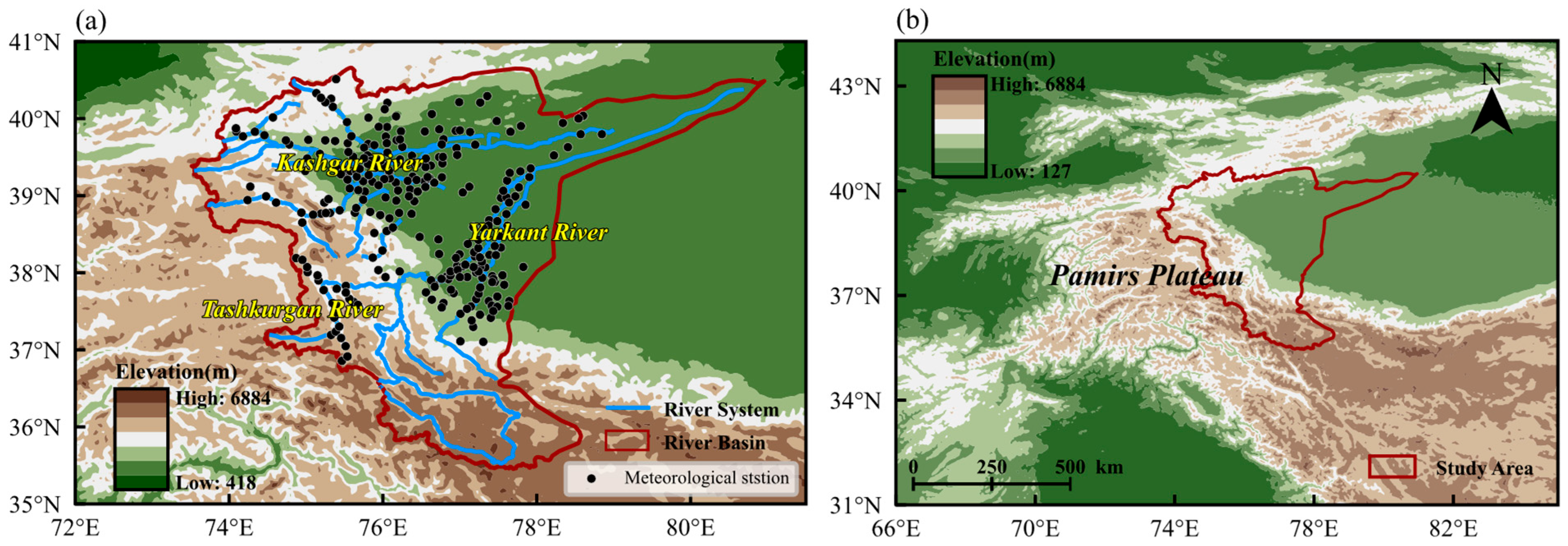

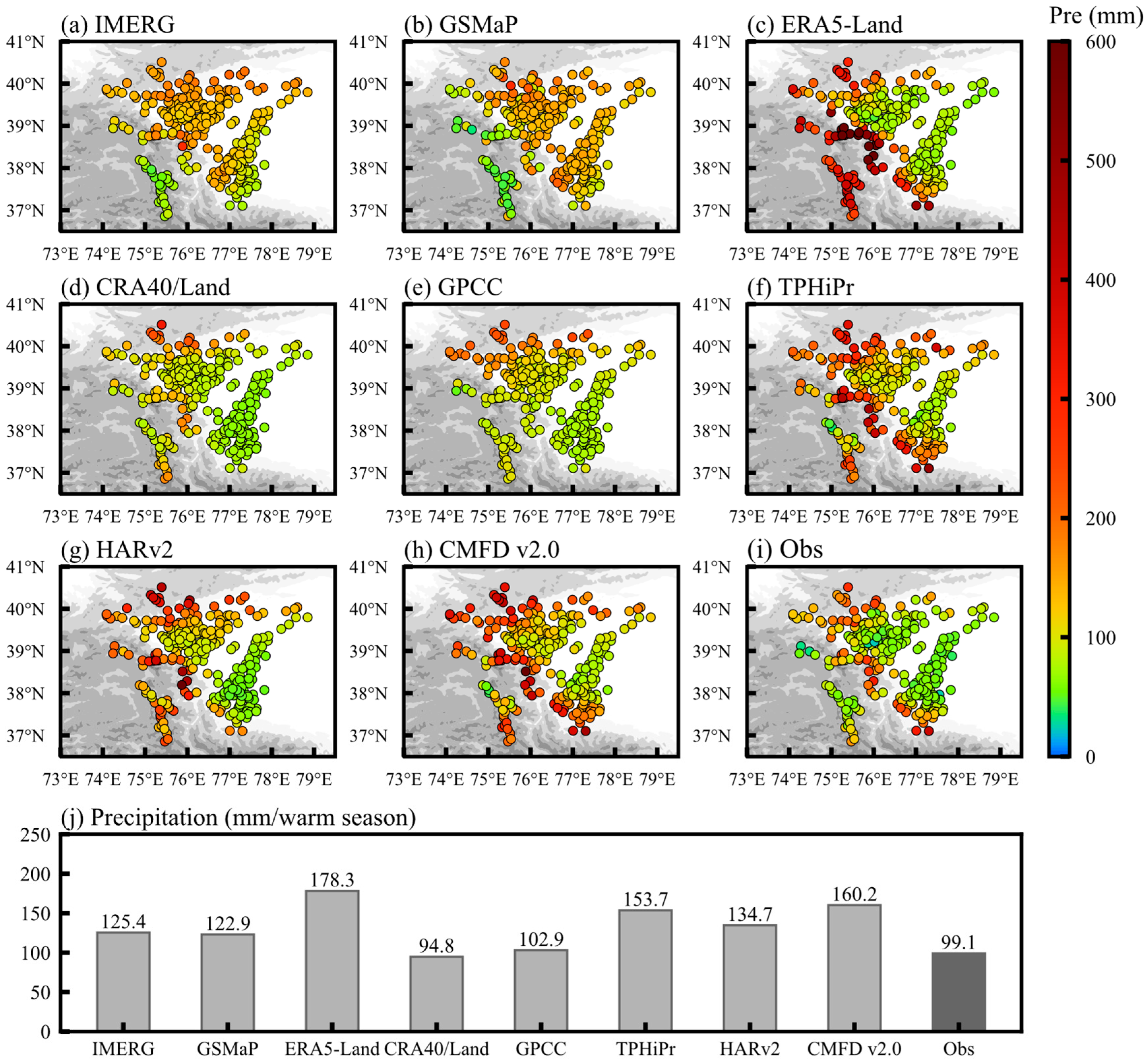
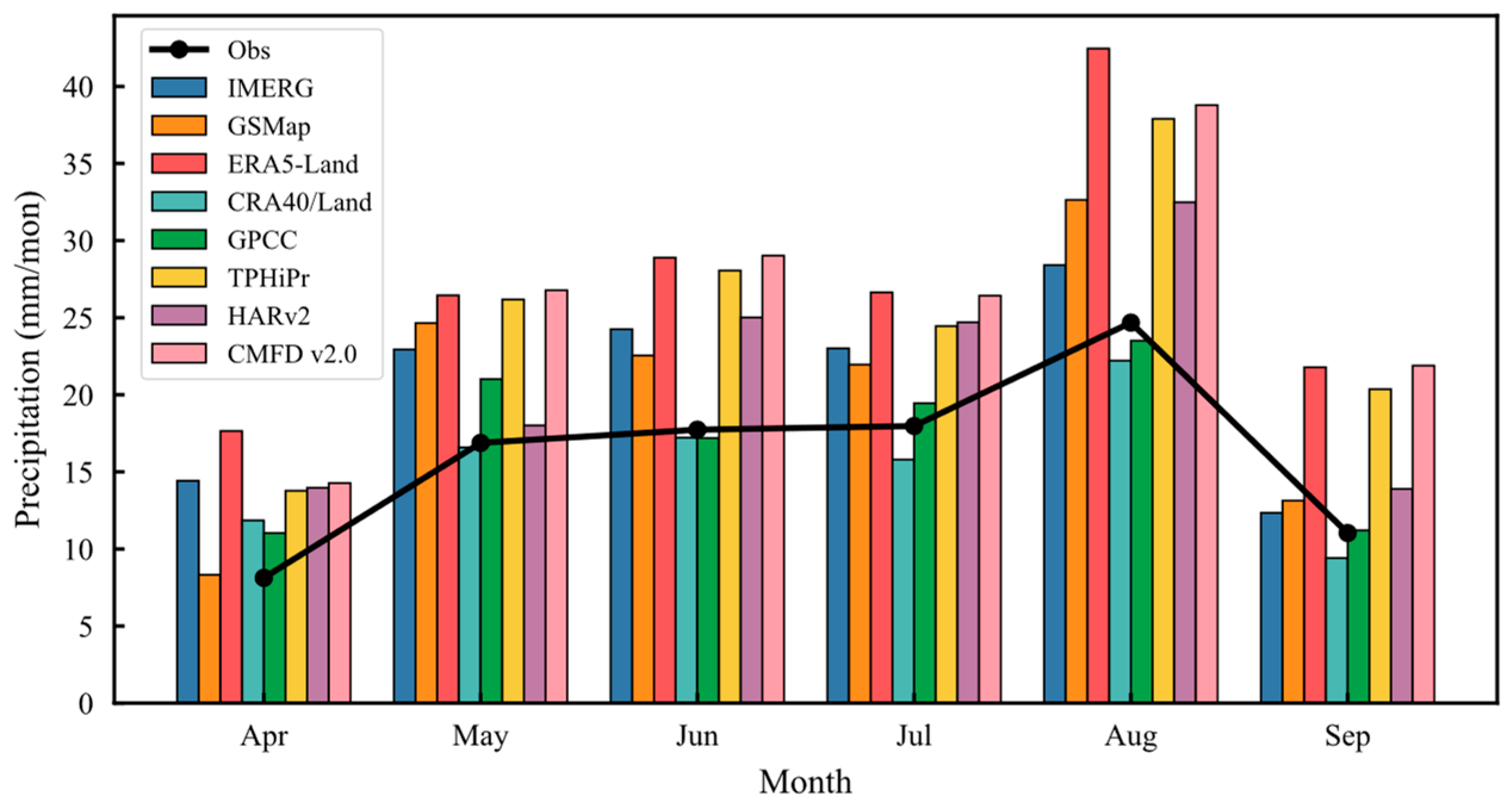
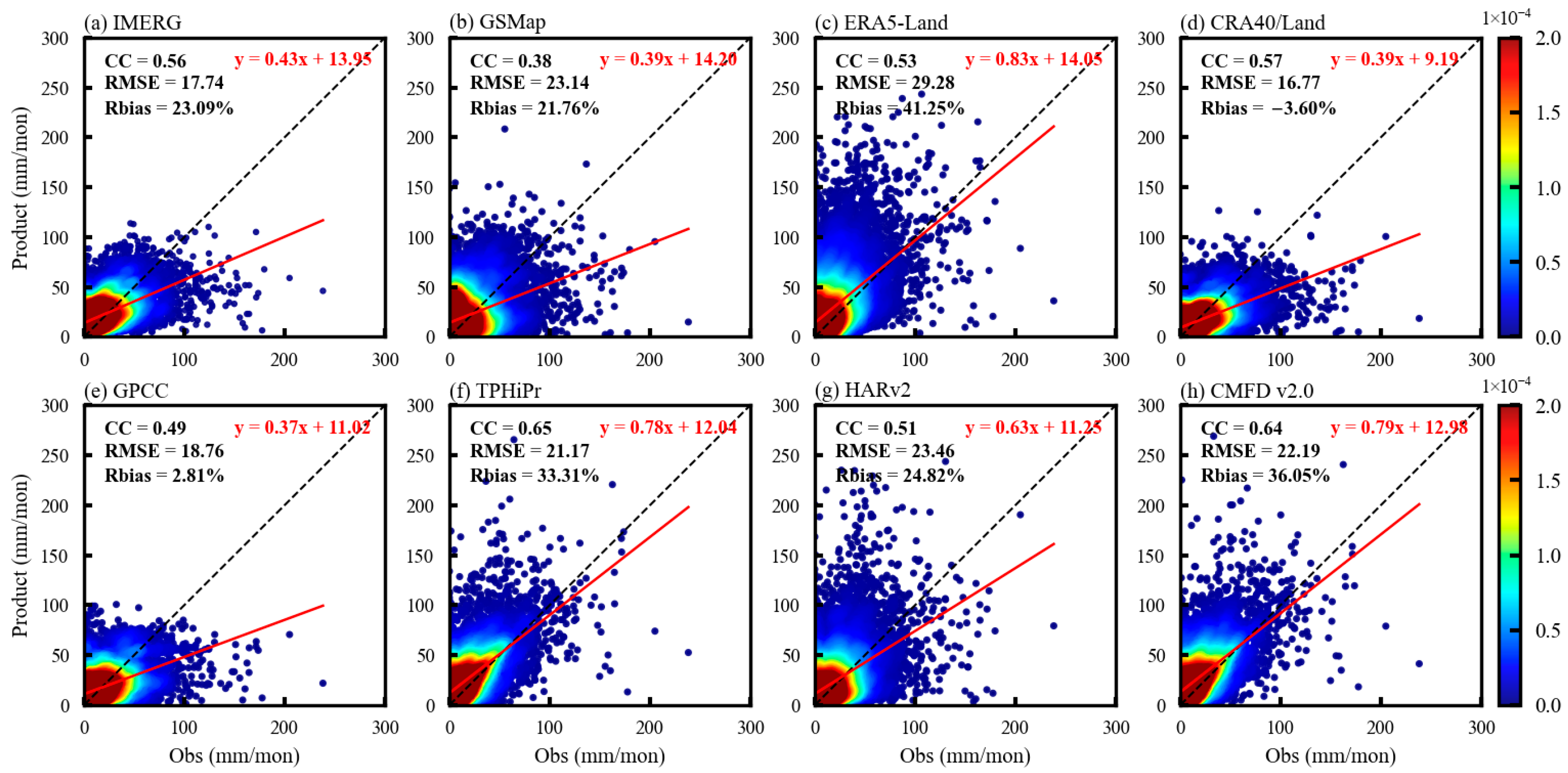
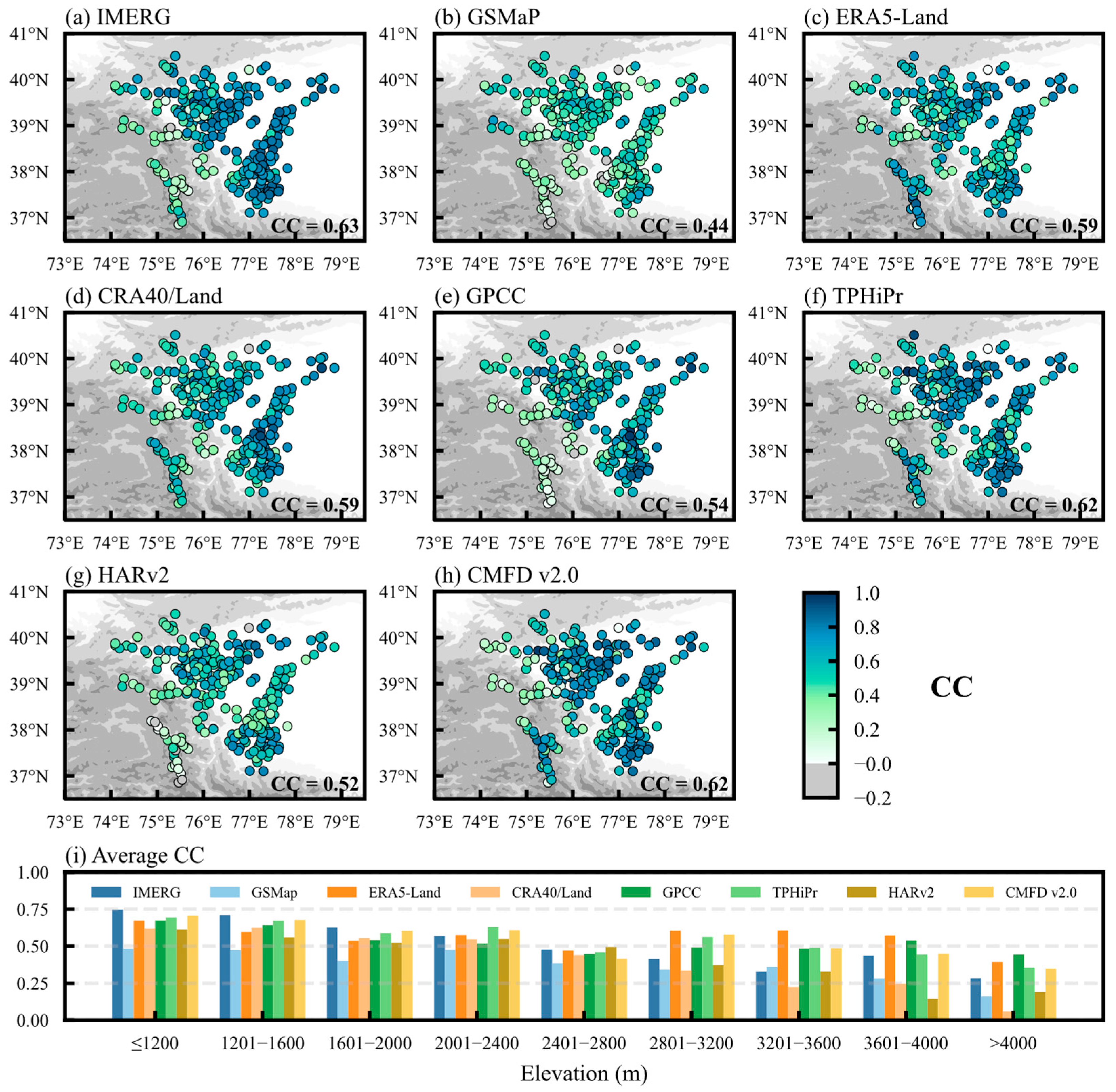


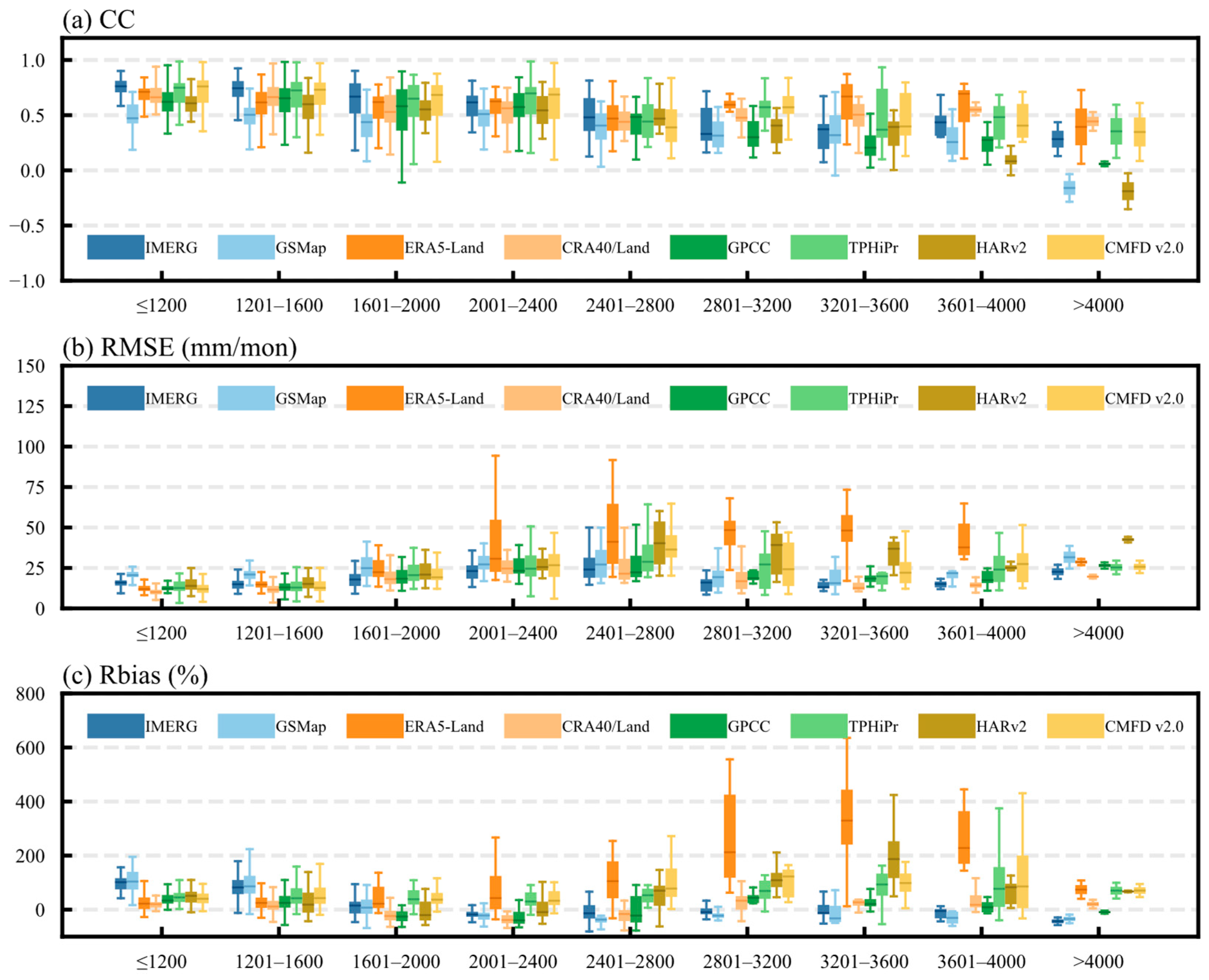
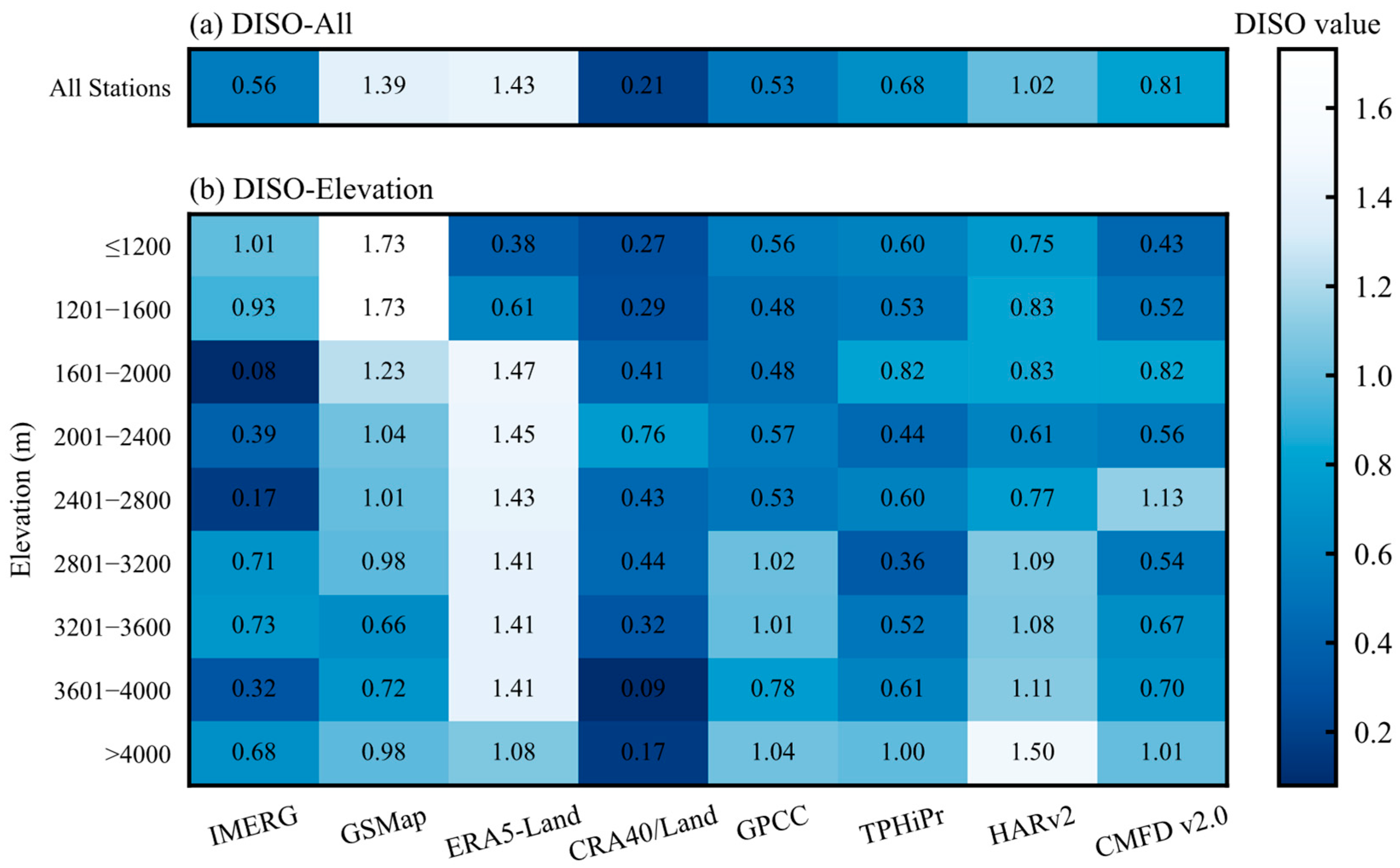
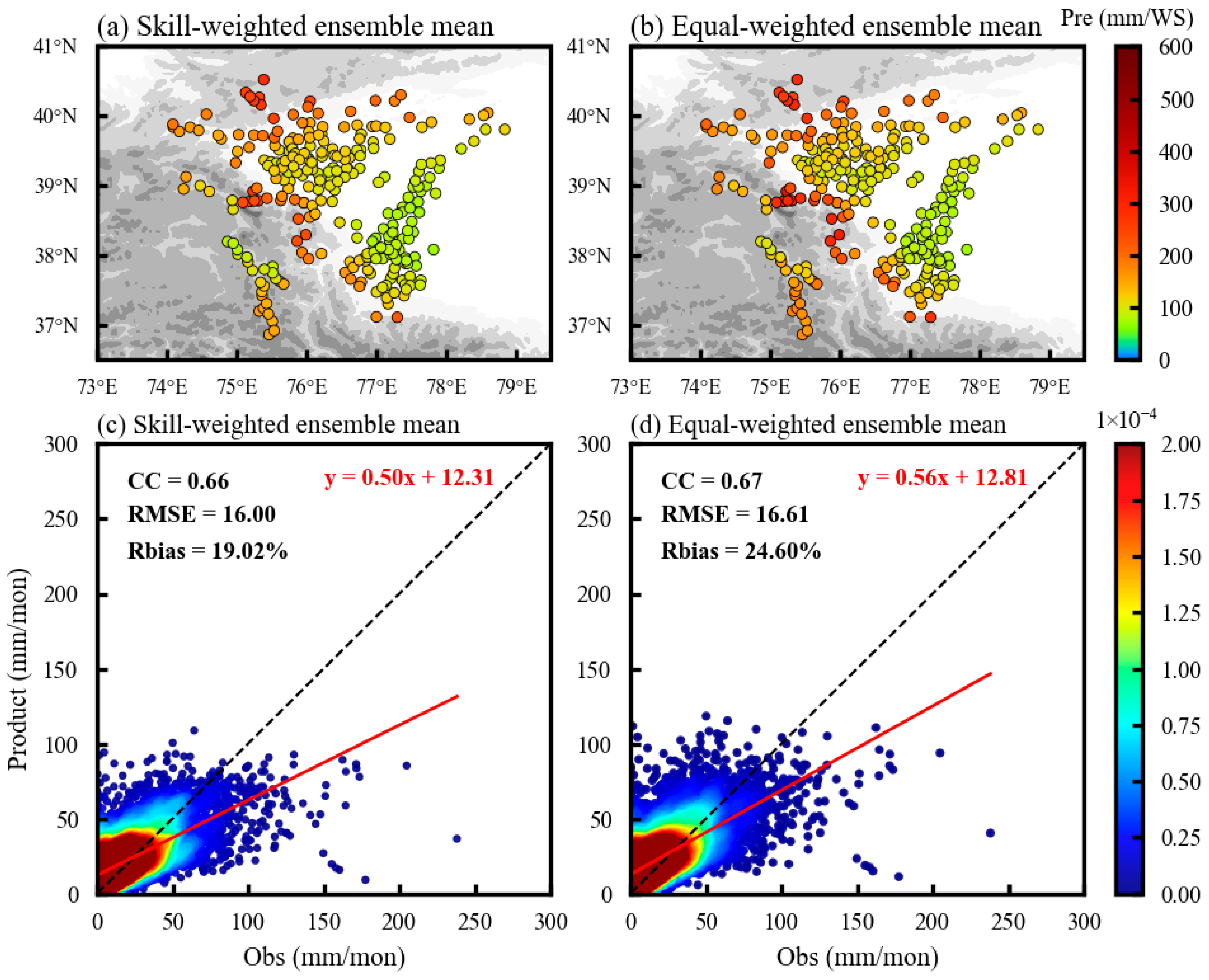

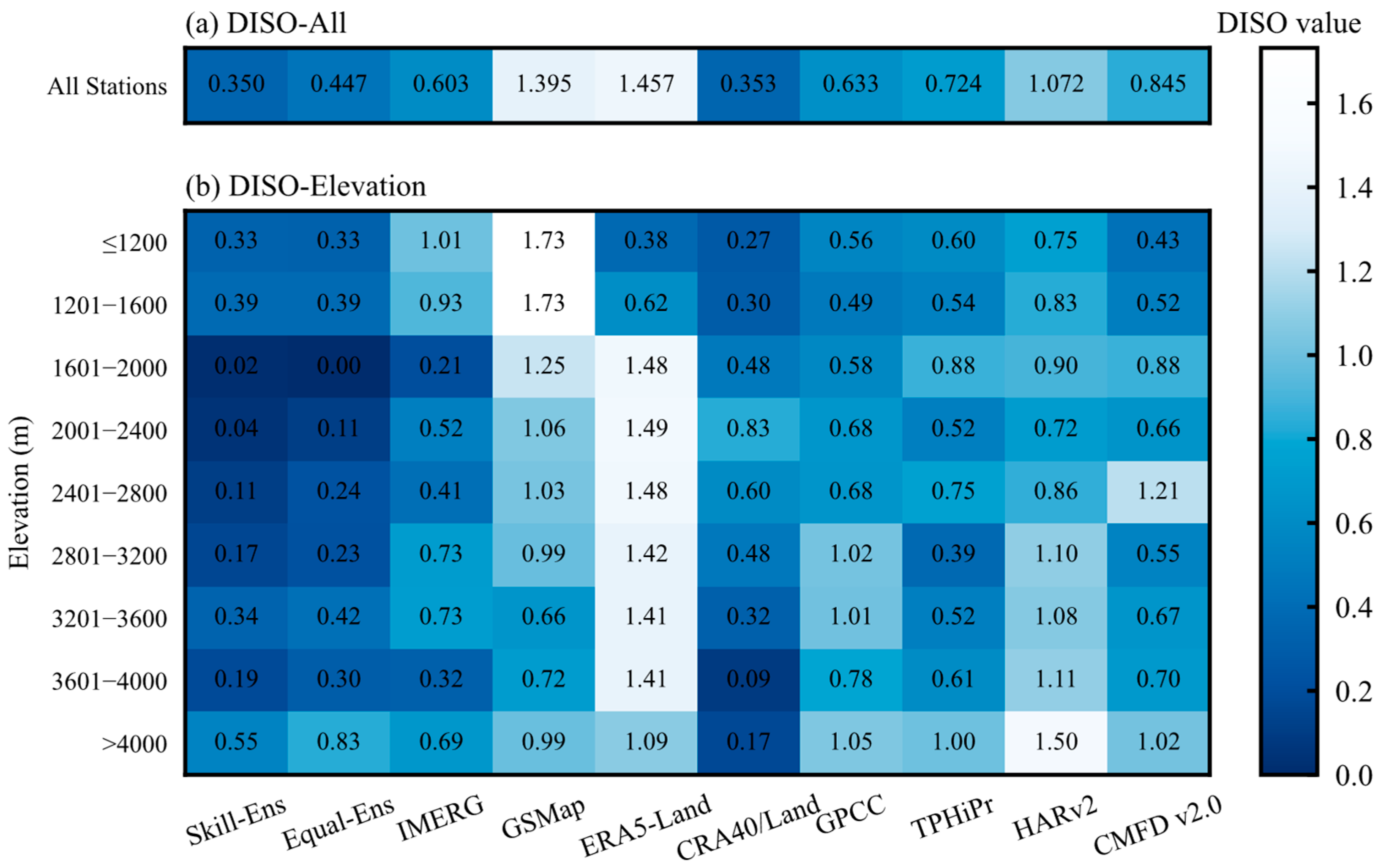

| Type | Dataset | Full Name/Version | Period | Spatial Resolution | References |
|---|---|---|---|---|---|
| Satellite dataset | IMERG | Integrated Multi-satellitE Retrievals for GPM/Final Precipitation L3 V07 | 2010–2024 | 0.1° | Huffman et al. [32] |
| GSMaP | Global Satellite Mapping/Gauge-calibrated Rainfall Product (V8) | 2010–2024 | 0.1° | Kubota et al. [33] | |
| Reanalysis dataset | ERA5-Land | ECMWF Reanalysis v5-Land | 2010–2023 | 0.1° | Muñoz-Sabater et al. [34] |
| CRA40/Land | The first-generation Chinese Global Land-surface Reanalysis | 2010–2024 | 0.25° | Liu et al. [35] | |
| Gridded dataset | GPCC | The Global Precipitation Climatology Centre/Full Data Monthly Version | 2010–2020 | 0.25° | Schneider et al. [36] |
| Fused dataset | TPHiPr | A long-term (1979–2020) high-resolution (1/30°, daily) precipitation dataset for the Third Pole region | 2010–2020 | 1/30° | Yang et al. [37] |
| HARv2 | The High Asia Refined analysis version2 | 2010–2023 | 10 km | Hamm et al. [38] | |
| CMFD v2.0 | China Meteorological Forcing Dataset v2.0 | 2010–2020 | 0.1° | He et al. [39] |
| Metrics | Formula | Perfect Value |
|---|---|---|
| Correlation Coefficient (CC) | 1 | |
| Root Mean Square Error (RMSE) | 0 | |
| Relative Bias (Rbias) | 0 |
| Weighting | IMERG | GSMaP | ERA5-Land | CRA40/Land | GPCC | TPHiPr | HARv2 | CMFD v2.0 |
|---|---|---|---|---|---|---|---|---|
| 0.18229 | 0.01740 | 0.01456 | 0.27115 | 0.19046 | 0.14819 | 0.06407 | 0.11188 |
Disclaimer/Publisher’s Note: The statements, opinions and data contained in all publications are solely those of the individual author(s) and contributor(s) and not of MDPI and/or the editor(s). MDPI and/or the editor(s) disclaim responsibility for any injury to people or property resulting from any ideas, methods, instructions or products referred to in the content. |
© 2025 by the authors. Licensee MDPI, Basel, Switzerland. This article is an open access article distributed under the terms and conditions of the Creative Commons Attribution (CC BY) license (https://creativecommons.org/licenses/by/4.0/).
Share and Cite
Yao, M.; Yao, J.; Mao, W.; Chen, J. Warm-Season Precipitation in the Eastern Pamir Plateau: Evaluation from Multi-Source Datasets and Elevation Dependence. Remote Sens. 2025, 17, 3302. https://doi.org/10.3390/rs17193302
Yao M, Yao J, Mao W, Chen J. Warm-Season Precipitation in the Eastern Pamir Plateau: Evaluation from Multi-Source Datasets and Elevation Dependence. Remote Sensing. 2025; 17(19):3302. https://doi.org/10.3390/rs17193302
Chicago/Turabian StyleYao, Mengying, Junqiang Yao, Weiyi Mao, and Jing Chen. 2025. "Warm-Season Precipitation in the Eastern Pamir Plateau: Evaluation from Multi-Source Datasets and Elevation Dependence" Remote Sensing 17, no. 19: 3302. https://doi.org/10.3390/rs17193302
APA StyleYao, M., Yao, J., Mao, W., & Chen, J. (2025). Warm-Season Precipitation in the Eastern Pamir Plateau: Evaluation from Multi-Source Datasets and Elevation Dependence. Remote Sensing, 17(19), 3302. https://doi.org/10.3390/rs17193302






